2007 ISUZU KB P190 torque
[x] Cancel search: torquePage 3838 of 6020
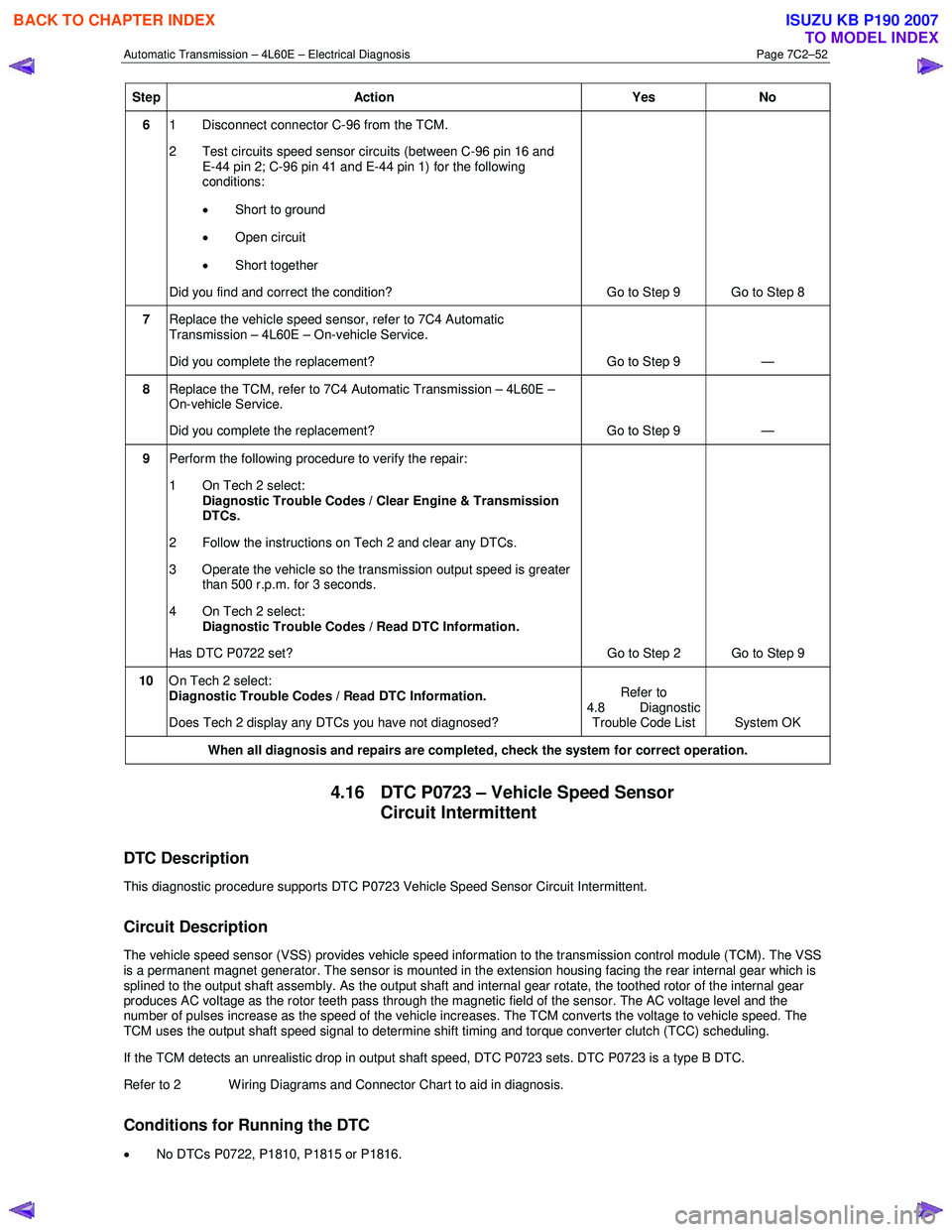
Automatic Transmission – 4L60E – Electrical Diagnosis Page 7C2–52
Step Action Yes No
6 1 Disconnect connector C-96 from the TCM.
2 Test circuits speed sensor circuits (between C-96 pin 16 and E-44 pin 2; C-96 pin 41 and E-44 pin 1) for the following
conditions:
• Short to ground
• Open circuit
• Short together
Did you find and correct the condition? Go to Step 9 Go to Step 8
7 Replace the vehicle speed sensor, refer to 7C4 Automatic
Transmission – 4L60E – On-vehicle Service.
Did you complete the replacement? Go to Step 9 —
8 Replace the TCM, refer to 7C4 Automatic Transmission – 4L60E –
On-vehicle Service.
Did you complete the replacement? Go to Step 9 —
9 Perform the following procedure to verify the repair:
1 On Tech 2 select: Diagnostic Trouble Codes / Clear Engine & Transmission
DTCs.
2 Follow the instructions on Tech 2 and clear any DTCs.
3 Operate the vehicle so the transmission output speed is greater than 500 r.p.m. for 3 seconds.
4 On Tech 2 select:
Diagnostic Trouble Codes / Read DTC Information.
Has DTC P0722 set? Go to Step 2 Go to Step 9
10 On Tech 2 select:
Diagnostic Trouble Codes / Read DTC Information.
Does Tech 2 display any DTCs you have not diagnosed? Refer to
4.8 Diagnostic Trouble Code List System OK
When all diagnosis and repairs are completed, check the system for correct operation.
4.16 DTC P0723 – Vehicle Speed Sensor
Circuit Intermittent
DTC Description
This diagnostic procedure supports DTC P0723 Vehicle Speed Sensor Circuit Intermittent.
Circuit Description
The vehicle speed sensor (VSS) provides vehicle speed information to the transmission control module (TCM). The VSS
is a permanent magnet generator. The sensor is mounted in the extension housing facing the rear internal gear which is
splined to the output shaft assembly. As the output shaft and internal gear rotate, the toothed rotor of the internal gear
produces AC voltage as the rotor teeth pass through the magnetic field of the sensor. The AC voltage level and the
number of pulses increase as the speed of the vehicle increases. The TCM converts the voltage to vehicle speed. The
TCM uses the output shaft speed signal to determine shift timing and torque converter clutch (TCC) scheduling.
If the TCM detects an unrealistic drop in output shaft speed, DTC P0723 sets. DTC P0723 is a type B DTC.
Refer to 2 W iring Diagrams and Connector Chart to aid in diagnosis.
Conditions for Running the DTC
• No DTCs P0722, P1810, P1815 or P1816.
BACK TO CHAPTER INDEX
TO MODEL INDEX
ISUZU KB P190 2007
Page 3839 of 6020

Automatic Transmission – 4L60E – Electrical Diagnosis Page 7C2–53
• Ignition voltage is 8 – 18 V.
• TFT is -40°C and 150°C.
• The engine run time is greater than 5 seconds.
• The throttle position is greater than 12 percent.
• The engine torque is 108 – 882 Nm.
Conditions for Setting the DTC
The transmission output shaft speed drops greater than 1,000 r.p.m. for at least 3.4 seconds.
Action Taken When the DTC Sets
• The TCM illuminates the MIL during the second consecutive trip in which the conditions for setting the DTC are met.
• The TCM commands maximum line pressure.
• The TCM freezes transmission adaptive functions.
• The TCM calculates vehicle speed from the automatic transmission input shaft speed sensor and commanded gear.
• At the time of the first failure, the TCM records the operating conditions when the conditions for setting the DTC are
met. The TCM stores this information as a Failure Record.
• At the time of the second failure, the ECM records the operating conditions when the conditions for setting the DTC
are met. The ECM stores this information as a Freeze Frame.
• The TCM stores DTC P0723 in TCM history.
Conditions for Clearing the DTC
• The ECM turns off the MIL after the sixth consecutive drive trip in which the TCM does not send a MIL illumination
request.
• Tech 2 can clear the DTC.
• The TCM clears the DTC from TCM history if the vehicle completes 40 warm-up cycles without an emission related
diagnostic fault occurring.
• The TCM cancels the default actions when the ignition is off long enough to power down the TCM.
Diagnostic Aids
•
Inspect the rear internal gear teeth for damage.
• Visually inspect the VSS for cracks or damage.
• Ensure the VSS is properly torqued to the transmission housing.
Test Description
The following numbers refer to the step numbers in the diagnostic table:
2 Disable the traction control system when performing this step. W hen the ignition key is cycled off and then cycled back on, the traction control system defaults to on.
3 Checks the VSS for correct resistance.
4 Checks if the VSS and associated circuits are shorted to ground.
5 Checks the VSS produces an AC voltage when the output shaft is rotated.
6 Checks the integrity of the circuits between the TCM and the VSS.
BACK TO CHAPTER INDEX
TO MODEL INDEX
ISUZU KB P190 2007
Page 3843 of 6020
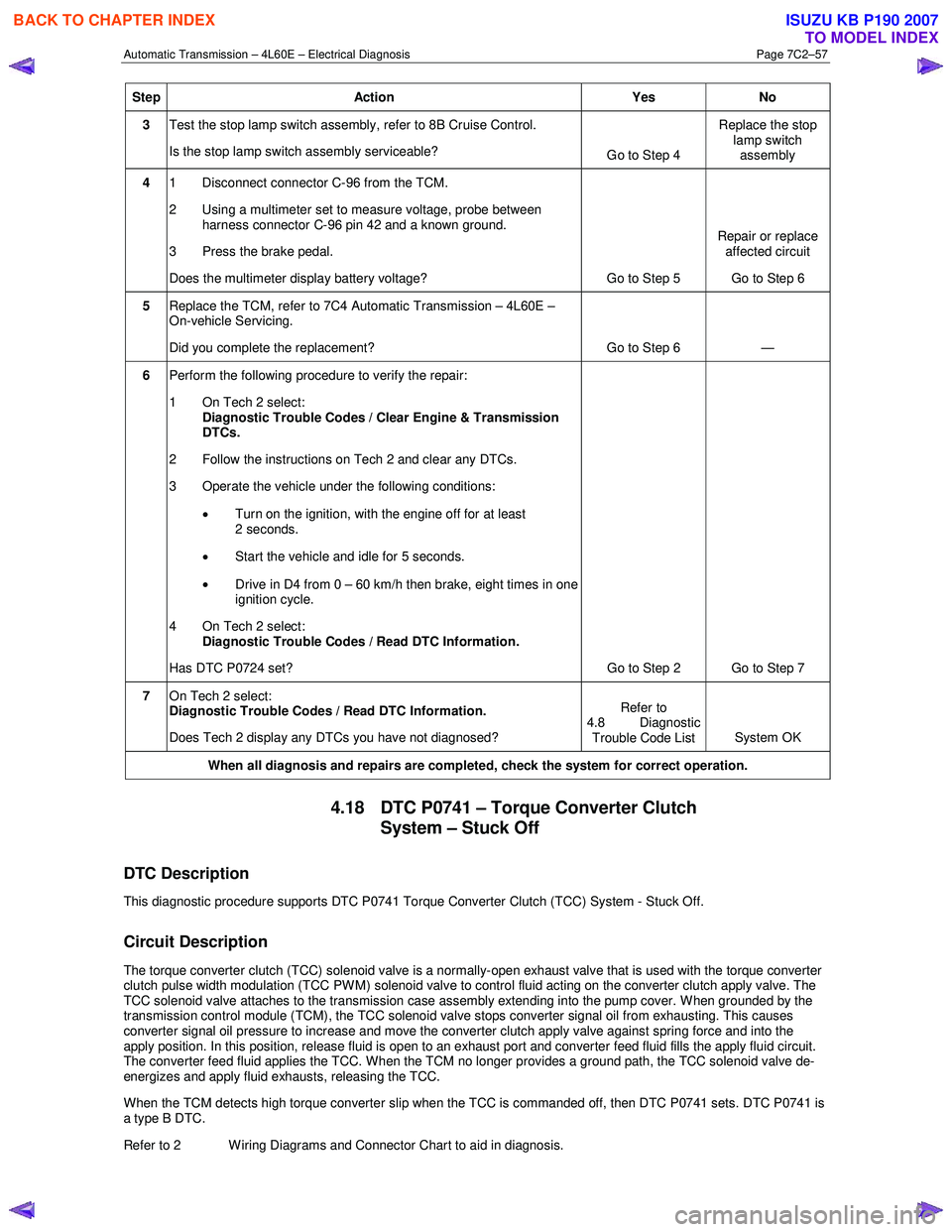
Automatic Transmission – 4L60E – Electrical Diagnosis Page 7C2–57
Step Action Yes No
3 Test the stop lamp switch assembly, refer to 8B Cruise Control.
Is the stop lamp switch assembly serviceable? Go to Step 4 Replace the stop
lamp switch assembly
4 1 Disconnect connector C-96 from the TCM.
2 Using a multimeter set to measure voltage, probe between harness connector C-96 pin 42 and a known ground.
3 Press the brake pedal.
Does the multimeter display battery voltage? Go to Step 5 Repair or replace
affected circuit
Go to Step 6
5 Replace the TCM, refer to 7C4 Automatic Transmission – 4L60E –
On-vehicle Servicing.
Did you complete the replacement? Go to Step 6 —
6 Perform the following procedure to verify the repair:
1 On Tech 2 select: Diagnostic Trouble Codes / Clear Engine & Transmission
DTCs.
2 Follow the instructions on Tech 2 and clear any DTCs.
3 Operate the vehicle under the following conditions:
• Turn on the ignition, with the engine off for at least
2 seconds.
• Start the vehicle and idle for 5 seconds.
• Drive in D4 from 0 – 60 km/h then brake, eight times in one
ignition cycle.
4 On Tech 2 select:
Diagnostic Trouble Codes / Read DTC Information.
Has DTC P0724 set? Go to Step 2 Go to Step 7
7 On Tech 2 select:
Diagnostic Trouble Codes / Read DTC Information.
Does Tech 2 display any DTCs you have not diagnosed? Refer to
4.8 Diagnostic Trouble Code List System OK
When all diagnosis and repairs are completed, check the
system for correct operation.
4.18 DTC P0741 – Torque Converter Clutch
System – Stuck Off
DTC Description
This diagnostic procedure supports DTC P0741 Torque Converter Clutch (TCC) System - Stuck Off.
Circuit Description
The torque converter clutch (TCC) solenoid valve is a normally-open exhaust valve that is used with the torque converter
clutch pulse width modulation (TCC PWM) solenoid valve to control fluid acting on the converter clutch apply valve. The
TCC solenoid valve attaches to the transmission case assembly extending into the pump cover. W hen grounded by the
transmission control module (TCM), the TCC solenoid valve stops converter signal oil from exhausting. This causes
converter signal oil pressure to increase and move the converter clutch apply valve against spring force and into the
apply position. In this position, release fluid is open to an exhaust port and converter feed fluid fills the apply fluid circu it.
The converter feed fluid applies the TCC. When the TCM no longer provides a ground path, the TCC solenoid valve de-
energizes and apply fluid exhausts, releasing the TCC.
When the TCM detects high torque converter slip when the TCC is commanded off, then DTC P0741 sets. DTC P0741 is
a type B DTC.
Refer to 2 W iring Diagrams and Connector Chart to aid in diagnosis.
BACK TO CHAPTER INDEX
TO MODEL INDEX
ISUZU KB P190 2007
Page 3844 of 6020
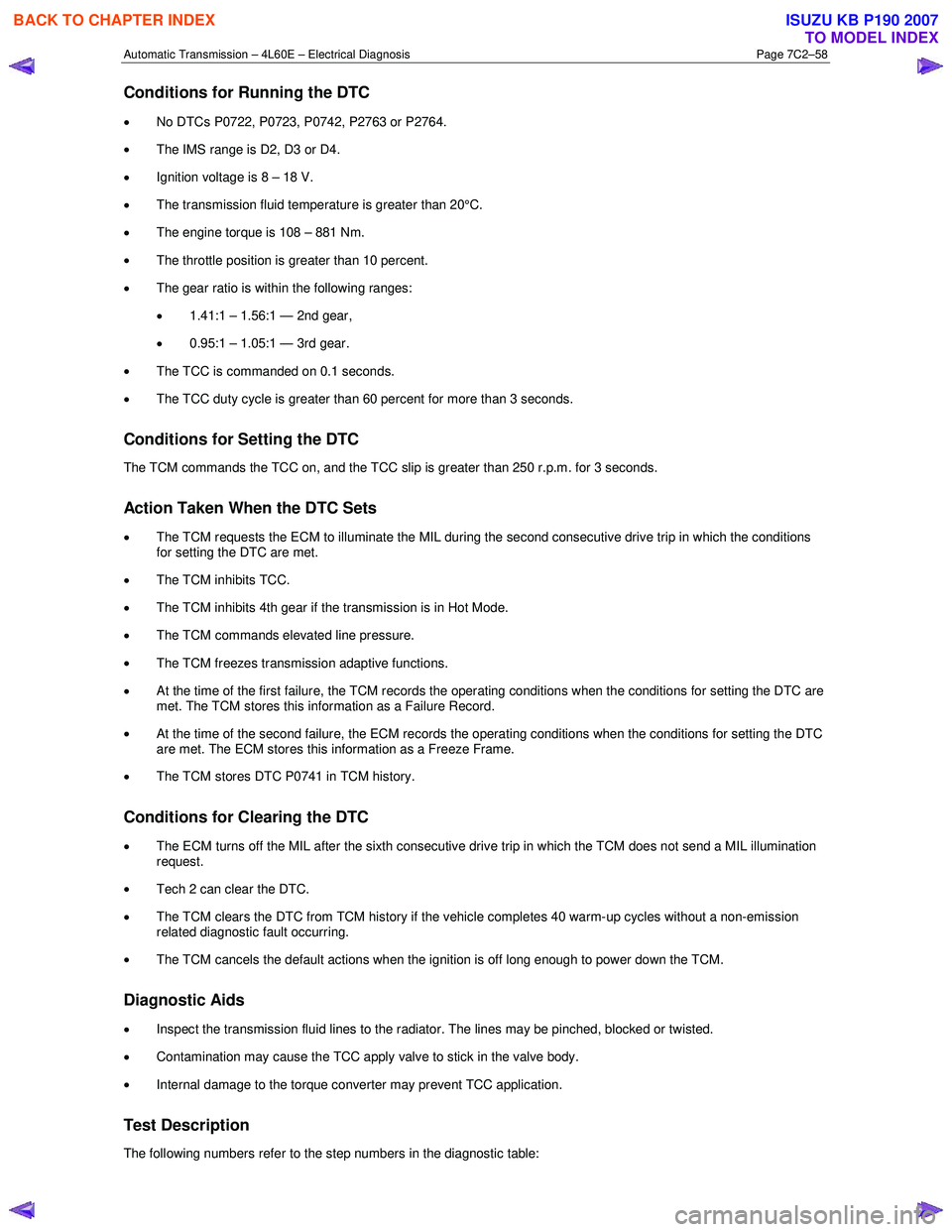
Automatic Transmission – 4L60E – Electrical Diagnosis Page 7C2–58
Conditions for Running the DTC
• No DTCs P0722, P0723, P0742, P2763 or P2764.
• The IMS range is D2, D3 or D4.
• Ignition voltage is 8 – 18 V.
• The transmission fluid temperature is greater than 20°C.
• The engine torque is 108 – 881 Nm.
• The throttle position is greater than 10 percent.
• The gear ratio is within the following ranges:
• 1.41:1 – 1.56:1 — 2nd gear,
• 0.95:1 – 1.05:1 — 3rd gear.
• The TCC is commanded on 0.1 seconds.
• The TCC duty cycle is greater than 60 percent for more than 3 seconds.
Conditions for Setting the DTC
The TCM commands the TCC on, and the TCC slip is greater than 250 r.p.m. for 3 seconds.
Action Taken When the DTC Sets
•
The TCM requests the ECM to illuminate the MIL during the second consecutive drive trip in which the conditions
for setting the DTC are met.
• The TCM inhibits TCC.
• The TCM inhibits 4th gear if the transmission is in Hot Mode.
• The TCM commands elevated line pressure.
• The TCM freezes transmission adaptive functions.
• At the time of the first failure, the TCM records the operating conditions when the conditions for setting the DTC are
met. The TCM stores this information as a Failure Record.
• At the time of the second failure, the ECM records the operating conditions when the conditions for setting the DTC
are met. The ECM stores this information as a Freeze Frame.
• The TCM stores DTC P0741 in TCM history.
Conditions for Clearing the DTC
• The ECM turns off the MIL after the sixth consecutive drive trip in which the TCM does not send a MIL illumination
request.
• Tech 2 can clear the DTC.
• The TCM clears the DTC from TCM history if the vehicle completes 40 warm-up cycles without a non-emission
related diagnostic fault occurring.
• The TCM cancels the default actions when the ignition is off long enough to power down the TCM.
Diagnostic Aids
• Inspect the transmission fluid lines to the radiator. The lines may be pinched, blocked or twisted.
• Contamination may cause the TCC apply valve to stick in the valve body.
• Internal damage to the torque converter may prevent TCC application.
Test Description
The following numbers refer to the step numbers in the diagnostic table:
BACK TO CHAPTER INDEX
TO MODEL INDEX
ISUZU KB P190 2007
Page 3846 of 6020
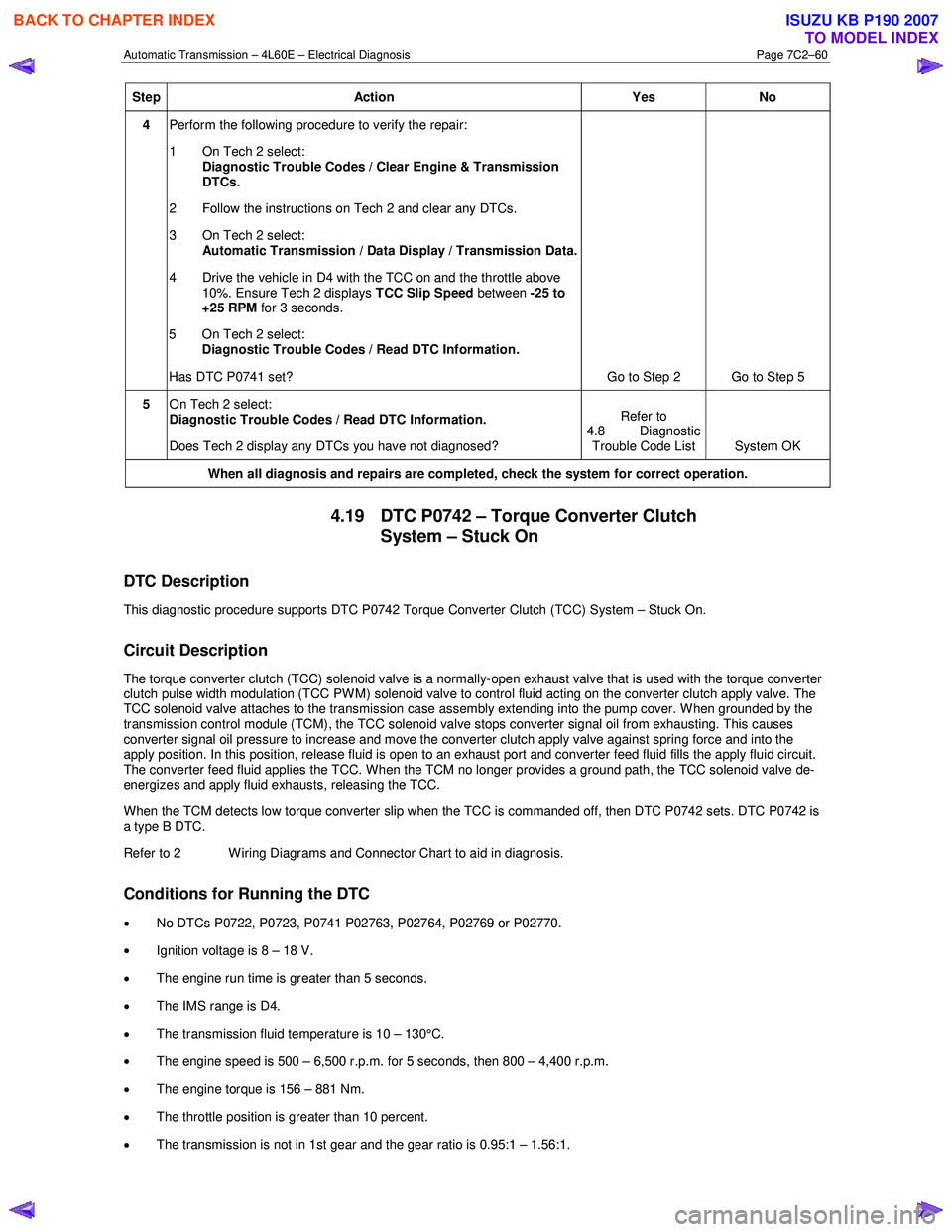
Automatic Transmission – 4L60E – Electrical Diagnosis Page 7C2–60
Step Action Yes No
4 Perform the following procedure to verify the repair:
1 On Tech 2 select: Diagnostic Trouble Codes / Clear Engine & Transmission
DTCs.
2 Follow the instructions on Tech 2 and clear any DTCs.
3 On Tech 2 select: Automatic Transmission / Data Display / Transmission Data.
4 Drive the vehicle in D4 with the TCC on and the throttle above 10%. Ensure Tech 2 displays TCC Slip Speed between -25 to
+25 RPM for 3 seconds.
5 On Tech 2 select:
Diagnostic Trouble Codes / Read DTC Information.
Has DTC P0741 set? Go to Step 2 Go to Step 5
5 On Tech 2 select:
Diagnostic Trouble Codes / Read DTC Information.
Does Tech 2 display any DTCs you have not diagnosed? Refer to
4.8 Diagnostic Trouble Code List System OK
When all diagnosis and repairs are completed, check the system for correct operation.
4.19 DTC P0742 – Torque Converter Clutch
System – Stuck On
DTC Description
This diagnostic procedure supports DTC P0742 Torque Converter Clutch (TCC) System – Stuck On.
Circuit Description
The torque converter clutch (TCC) solenoid valve is a normally-open exhaust valve that is used with the torque converter
clutch pulse width modulation (TCC PWM) solenoid valve to control fluid acting on the converter clutch apply valve. The
TCC solenoid valve attaches to the transmission case assembly extending into the pump cover. W hen grounded by the
transmission control module (TCM), the TCC solenoid valve stops converter signal oil from exhausting. This causes
converter signal oil pressure to increase and move the converter clutch apply valve against spring force and into the
apply position. In this position, release fluid is open to an exhaust port and converter feed fluid fills the apply fluid circu it.
The converter feed fluid applies the TCC. When the TCM no longer provides a ground path, the TCC solenoid valve de-
energizes and apply fluid exhausts, releasing the TCC.
W hen the TCM detects low torque converter slip when the TCC is commanded off, then DTC P0742 sets. DTC P0742 is
a type B DTC.
Refer to 2 W iring Diagrams and Connector Chart to aid in diagnosis.
Conditions for Running the DTC
• No DTCs P0722, P0723, P0741 P02763, P02764, P02769 or P02770.
• Ignition voltage is 8 – 18 V.
• The engine run time is greater than 5 seconds.
• The IMS range is D4.
• The transmission fluid temperature is 10 – 130°C.
• The engine speed is 500 – 6,500 r.p.m. for 5 seconds, then 800 – 4,400 r.p.m.
• The engine torque is 156 – 881 Nm.
• The throttle position is greater than 10 percent.
• The transmission is not in 1st gear and the gear ratio is 0.95:1 – 1.56:1.
BACK TO CHAPTER INDEX
TO MODEL INDEX
ISUZU KB P190 2007
Page 3847 of 6020
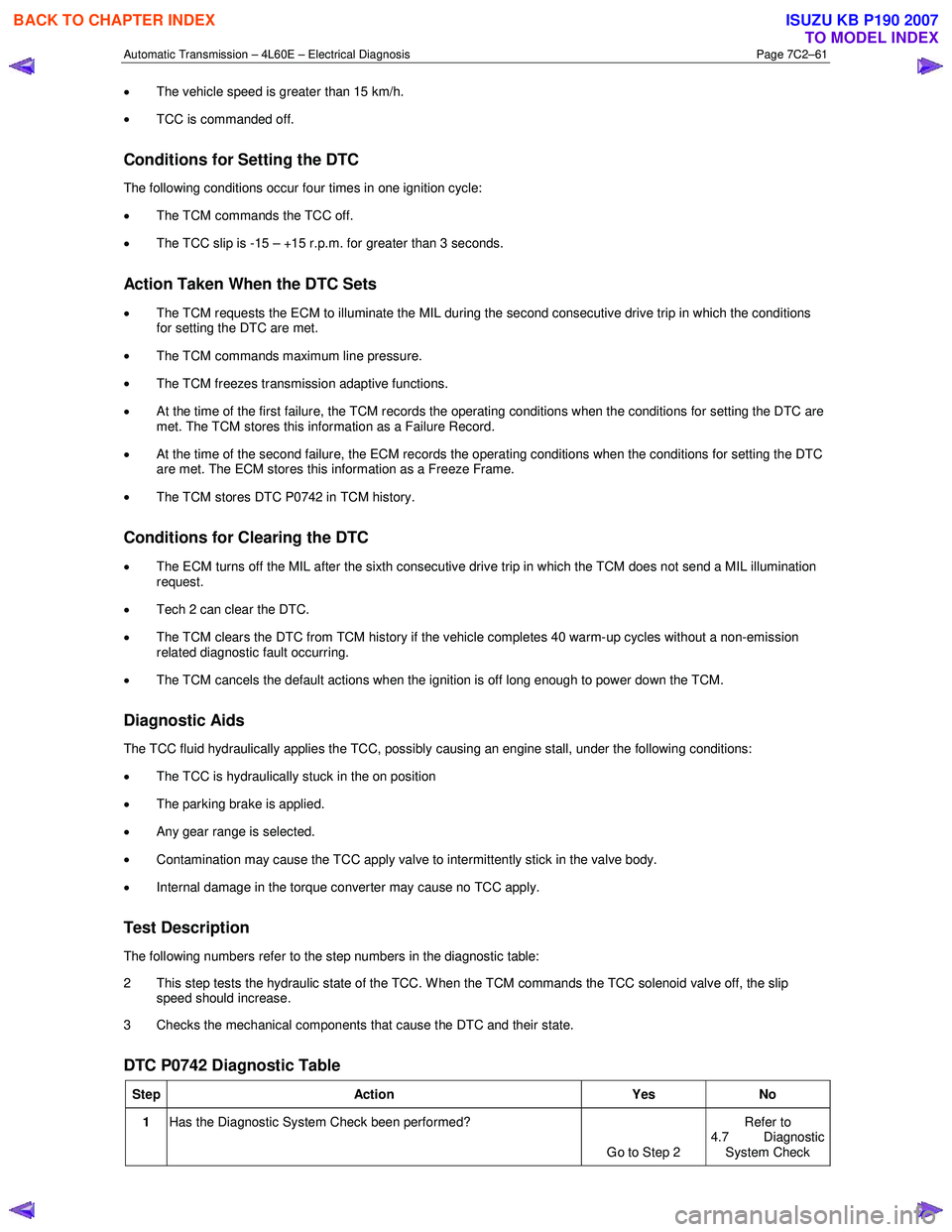
Automatic Transmission – 4L60E – Electrical Diagnosis Page 7C2–61
• The vehicle speed is greater than 15 km/h.
• TCC is commanded off.
Conditions for Setting the DTC
The following conditions occur four times in one ignition cycle:
• The TCM commands the TCC off.
• The TCC slip is -15 – +15 r.p.m. for greater than 3 seconds.
Action Taken When the DTC Sets
•
The TCM requests the ECM to illuminate the MIL during the second consecutive drive trip in which the conditions
for setting the DTC are met.
• The TCM commands maximum line pressure.
• The TCM freezes transmission adaptive functions.
• At the time of the first failure, the TCM records the operating conditions when the conditions for setting the DTC are
met. The TCM stores this information as a Failure Record.
• At the time of the second failure, the ECM records the operating conditions when the conditions for setting the DTC
are met. The ECM stores this information as a Freeze Frame.
• The TCM stores DTC P0742 in TCM history.
Conditions for Clearing the DTC
• The ECM turns off the MIL after the sixth consecutive drive trip in which the TCM does not send a MIL illumination
request.
• Tech 2 can clear the DTC.
• The TCM clears the DTC from TCM history if the vehicle completes 40 warm-up cycles without a non-emission
related diagnostic fault occurring.
• The TCM cancels the default actions when the ignition is off long enough to power down the TCM.
Diagnostic Aids
The TCC fluid hydraulically applies the TCC, possibly causing an engine stall, under the following conditions:
• The TCC is hydraulically stuck in the on position
• The parking brake is applied.
• Any gear range is selected.
• Contamination may cause the TCC apply valve to intermittently stick in the valve body.
• Internal damage in the torque converter may cause no TCC apply.
Test Description
The following numbers refer to the step numbers in the diagnostic table:
2 This step tests the hydraulic state of the TCC. W hen the TCM commands the TCC solenoid valve off, the slip speed should increase.
3 Checks the mechanical components that cause the DTC and their state.
DTC P0742 Diagnostic Table
Step Action Yes No
1 Has the Diagnostic System Check been performed?
Go to Step 2 Refer to
4.7 Diagnostic
System Check
BACK TO CHAPTER INDEX
TO MODEL INDEX
ISUZU KB P190 2007
Page 3851 of 6020
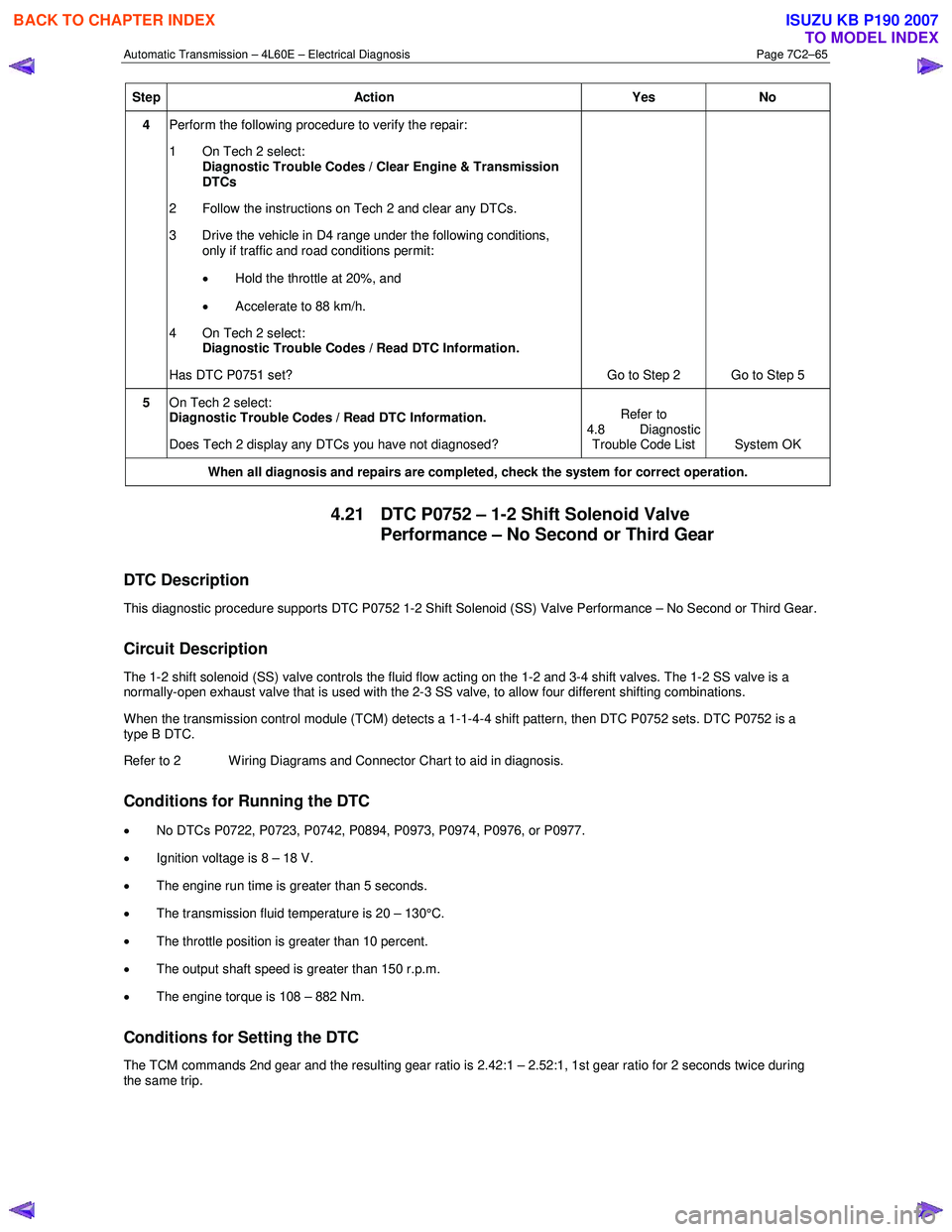
Automatic Transmission – 4L60E – Electrical Diagnosis Page 7C2–65
Step Action Yes No
4 Perform the following procedure to verify the repair:
1 On Tech 2 select: Diagnostic Trouble Codes / Clear Engine & Transmission
DTCs
2 Follow the instructions on Tech 2 and clear any DTCs.
3 Drive the vehicle in D4 range under the following conditions, only if traffic and road conditions permit:
• Hold the throttle at 20%, and
• Accelerate to 88 km/h.
4 On Tech 2 select:
Diagnostic Trouble Codes / Read DTC Information.
Has DTC P0751 set? Go to Step 2 Go to Step 5
5 On Tech 2 select:
Diagnostic Trouble Codes / Read DTC Information.
Does Tech 2 display any DTCs you have not diagnosed? Refer to
4.8 Diagnostic Trouble Code List System OK
When all diagnosis and repairs are completed, check the
system for correct operation.
4.21 DTC P0752 – 1-2 Shift Solenoid Valve
Performance – No Second or Third Gear
DTC Description
This diagnostic procedure supports DTC P0752 1-2 Shift Solenoid (SS) Valve Performance – No Second or Third Gear.
Circuit Description
The 1-2 shift solenoid (SS) valve controls the fluid flow acting on the 1-2 and 3-4 shift valves. The 1-2 SS valve is a
normally-open exhaust valve that is used with the 2-3 SS valve, to allow four different shifting combinations.
When the transmission control module (TCM) detects a 1-1-4-4 shift pattern, then DTC P0752 sets. DTC P0752 is a
type B DTC.
Refer to 2 W iring Diagrams and Connector Chart to aid in diagnosis.
Conditions for Running the DTC
• No DTCs P0722, P0723, P0742, P0894, P0973, P0974, P0976, or P0977.
• Ignition voltage is 8 – 18 V.
• The engine run time is greater than 5 seconds.
• The transmission fluid temperature is 20 – 130°C.
• The throttle position is greater than 10 percent.
• The output shaft speed is greater than 150 r.p.m.
• The engine torque is 108 – 882 Nm.
Conditions for Setting the DTC
The TCM commands 2nd gear and the resulting gear ratio is 2.42:1 – 2.52:1, 1st gear ratio for 2 seconds twice during
the same trip.
BACK TO CHAPTER INDEX
TO MODEL INDEX
ISUZU KB P190 2007
Page 3854 of 6020
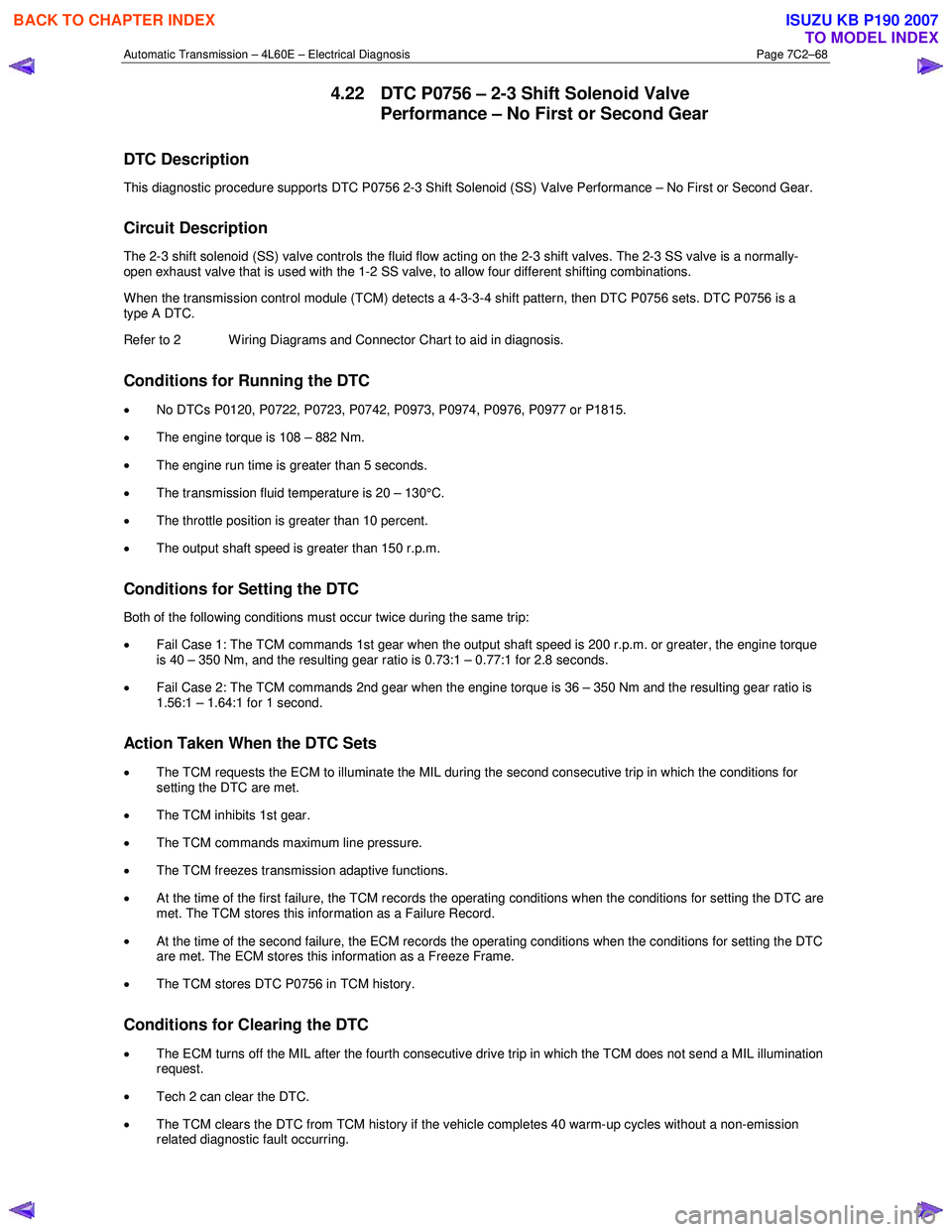
Automatic Transmission – 4L60E – Electrical Diagnosis Page 7C2–68
4.22 DTC P0756 – 2-3 Shift Solenoid Valve
Performance – No First or Second Gear
DTC Description
This diagnostic procedure supports DTC P0756 2-3 Shift Solenoid (SS) Valve Performance – No First or Second Gear.
Circuit Description
The 2-3 shift solenoid (SS) valve controls the fluid flow acting on the 2-3 shift valves. The 2-3 SS valve is a normally-
open exhaust valve that is used with the 1-2 SS valve, to allow four different shifting combinations.
When the transmission control module (TCM) detects a 4-3-3-4 shift pattern, then DTC P0756 sets. DTC P0756 is a
type A DTC.
Refer to 2 W iring Diagrams and Connector Chart to aid in diagnosis.
Conditions for Running the DTC
• No DTCs P0120, P0722, P0723, P0742, P0973, P0974, P0976, P0977 or P1815.
• The engine torque is 108 – 882 Nm.
• The engine run time is greater than 5 seconds.
• The transmission fluid temperature is 20 – 130°C.
• The throttle position is greater than 10 percent.
• The output shaft speed is greater than 150 r.p.m.
Conditions for Setting the DTC
Both of the following conditions must occur twice during the same trip:
• Fail Case 1: The TCM commands 1st gear when the output shaft speed is 200 r.p.m. or greater, the engine torque
is 40 – 350 Nm, and the resulting gear ratio is 0.73:1 – 0.77:1 for 2.8 seconds.
• Fail Case 2: The TCM commands 2nd gear when the engine torque is 36 – 350 Nm and the resulting gear ratio is
1.56:1 – 1.64:1 for 1 second.
Action Taken When the DTC Sets
• The TCM requests the ECM to illuminate the MIL during the second consecutive trip in which the conditions for
setting the DTC are met.
• The TCM inhibits 1st gear.
• The TCM commands maximum line pressure.
• The TCM freezes transmission adaptive functions.
• At the time of the first failure, the TCM records the operating conditions when the conditions for setting the DTC are
met. The TCM stores this information as a Failure Record.
• At the time of the second failure, the ECM records the operating conditions when the conditions for setting the DTC
are met. The ECM stores this information as a Freeze Frame.
• The TCM stores DTC P0756 in TCM history.
Conditions for Clearing the DTC
• The ECM turns off the MIL after the fourth consecutive drive trip in which the TCM does not send a MIL illumination
request.
• Tech 2 can clear the DTC.
• The TCM clears the DTC from TCM history if the vehicle completes 40 warm-up cycles without a non-emission
related diagnostic fault occurring.
BACK TO CHAPTER INDEX
TO MODEL INDEX
ISUZU KB P190 2007